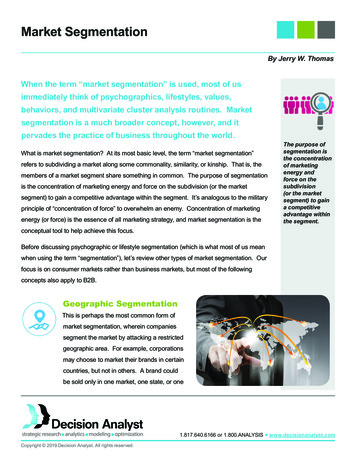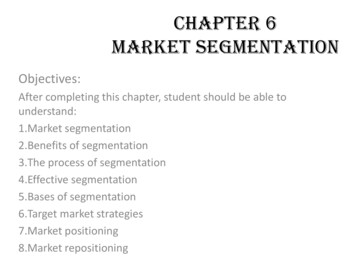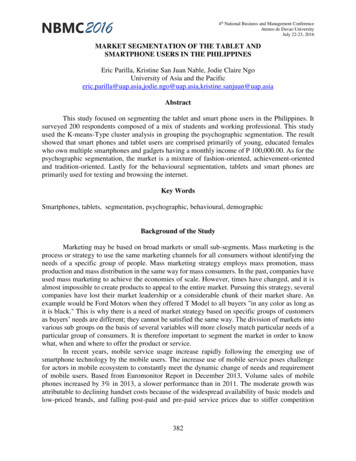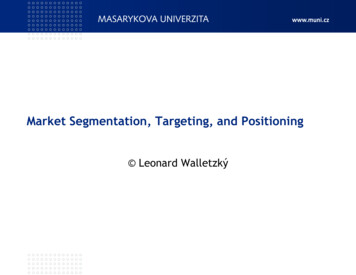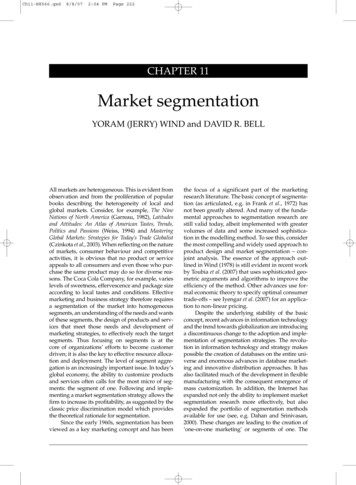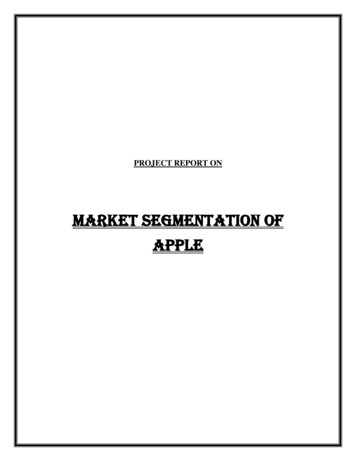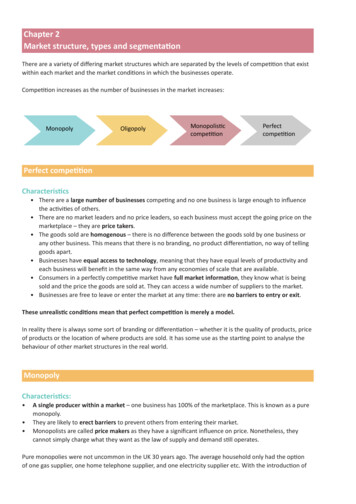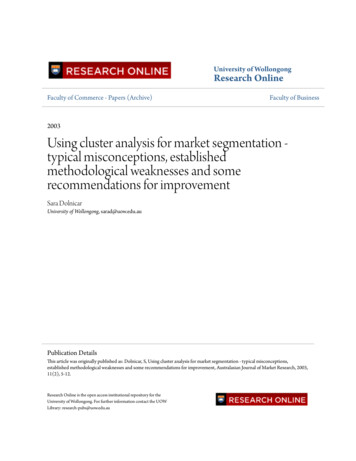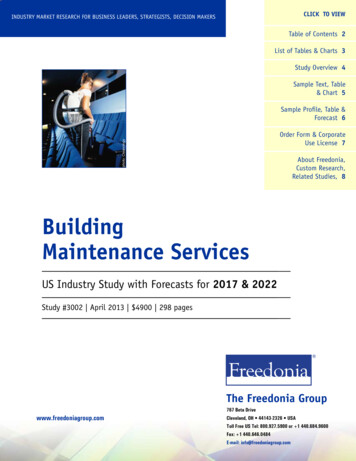
Transcription
Market Segmentation:The Role of Opaque Travel AgenciesDmitry Shapiro and Xianwen Shi First Draft: October 2006This Draft: February 2008 Shapiro: Belk College of Business, University of North Carolina, 9201 University City Boulevard, Charlotte NC28223-0001, USA; email address: dashapir@uncc.edu. Shi: Department of Economics, University of Toronto, 150 St.George Street, Toronto, ON M5S 3G7, Canada; email address: xianwen.shi@utoronto.ca.1
ABSTRACTThis paper investigates the role of discount travel agencies such as Priceline and Hotwire inthe market segmentation of the hotel and airline industries. These agencies conceal importantcharacteristics of the offered services, such as hotel locations or flight schedules. We explicitlymodel this opaque feature and show that it enables service providers to price discriminate betweenthose customers who are sensitive to service characteristics and those who are not. Service providerscan profit from such discrimination despite the fact that the opaque feature virtually erases productdifferentiation and thus intensifies competition. The reason is that the intensified competition forless sensitive customers enables service providers to commit to a higher price for more sensitivecustomers, which leads to higher profits overall. This explains why airlines or hotels are willing tolose the advantage of product differentiation and offer services through discount travel agencies.Keywords: market segmentation, opaque travel agency, separation equilibrium, price discrimination.Jel Classification: D43, D82, L11, M312
1IntroductionIn the past few years, the emergence of online electronic markets dramatically changed the leisuretravel industry, making it one of the most developed online businesses. In the United States, onlineleisure travel bookings more than tripled from 2001 to 2005,1 and are expected to reach about 69 billion in 2007, or 35% of all online consumer spending.2 According to PhoCusWright, anindependent consultancy, online leisure travel bookings in the United States will surpass offlinebookings in volume for the first time in 2007.3Expedia (who owns Expedia.com and Hotels.com), Travelocity and Orbitz are the three dominant online travel agencies (OTAs). Two niche players, Hotwire.com (acquired by Expedia in 2003)and Priceline.com, have emerged that offer services with 30 50% price discounts as compared tooffline reservation prices or prices of other OTAs. These discount agencies have gained sizeablemarket shares. According to MarketMetrix, Priceline and Hotwire combined account for 6.7% ofworldwide online hotel bookings in 2006, comparable to Expedia.com (10.4%), Travelocity.com(6.8%) and Orbitz.com (4.9%).4,5 In November 2007, Priceline reported a gross profit of 479 million and gross travel bookings of 3.6 billon worldwide for the first three quarters (a 58.9% and40.6% increase compared to the same period in 2006, respectively).6The defining feature of Priceline and Hotwire is that they do not tell customers certain itinerarydetails, such as brand, the time of flight departure or exact hotel location, until the transactionis completed, and thus they are often referred to as “opaque” travel sites.7 Both sites used tooffer opaque services exclusively. Recently, Priceline (in 2003) and Hotwire (in 2005) introducedthe traditional transparent retail option with disclosed prices and itinerary details. When offeringopaque services, the opaque agency is the merchant of record and are responsible for setting prices12Source: New York Times. (Late Edition (East Coast)). May 30, 2005. pg. C.6.Source: http://www.comscore.com/press/release.asp?press 1545. Press release of comScore.com from July 30,2007.3Source: http://store.phocuswright.com/phuontrovsee.html. PhoCusWright’s U.S. Online Travel Overview, 2007.4Source: MarketMetrics.com, http://marketmetrix.com/en/default.aspx?s research&p research6.5These figures likely underestimate the importance of Priceline and Hotwire in the leisure travel market becausethey include five-star hotels that are usually not offered by opaque sites (with the exception of Las Vegas). The figuresalso include sales in small cities where it is infeasible for opaque sites to operate — opaque sites need sufficientlymany participating hotels to form an opaque product.6Priceline.com 2007 Q3 report, Form 10-Q, p. 23 and p. 26.7There is a slight difference between the two sites. Hotwire discloses the prices for opaque hotels or car rentalsso consumers do not bid and simply decide whether to buy or not. Priceline, on the other hand, asks consumers to“Name Your Own Price” for the opaque service requested.3
and the revenues generated are called “merchant revenues”. In contrast, the revenues generatedfrom the traditional retail services are primarily “agency revenues”, where the price is set bythe service providers and the opaque agency charges commissions. Opaque sales remain definingidentity and major revenue source for both sites. In 2006, for example, Priceline reported that themerchant revenues “represented the substantial majority of our total revenues”.8The opaque feature of Priceline and Hotwire has a strong impact on the competition betweenservice providers. When the complete information about flights (or hotels) is available they are differentiated products. Hotels differ from each other in their identity, locations and amenities; flightsdiffer in their departure times, the number of connections, and the length of layovers. It is wellknown that product differentiation reduces competition and increases prices and profit (Hotelling(1929)). In contrast, products sold through Priceline and Hotwire are indistinguishable for customers and become essentially perfect substitutes, which leads to Bertrand competition and drivesdown both price-cost margin and firms’ profit.The question is then: why would hotels and airline companies be willing to sell their productsthrough Priceline/Hotwire and lose the advantage (and profit) that product differentiation givesthem?One explanation is that firms use OTAs with the opaque feature to response to changes indemand without jeopardizing existing branding and pricing policies (formalized in Wang et al.(2006)). While this may be a part of the story we believe that this does not capture the wholepicture. First, Priceline and Hotwire offer tickets during peak seasons (such as Christmas) andto popular destinations where the demand is traditionally high. Second, the amount of concealedinformation is more than the hotel or airline’s identity, which also suggests that the purpose ofthese agencies is more than only a facility to anonymously respond to demand changes.Another possible explanation is that opaque sites can help sellers reach new consumers with lowvaluations who otherwise remain outside the market. The low price of opaque services enables sellersto attract low value customers who are sensitive to price but less sensitive to service characteristics.On the other hand, the opaque feature prevents high value customers from switching to opaquechannels because they would prefer to know itinerary details.While this explanation is quite possible, we show that opaque agencies enable hotels and airlinesto do much more than just attract low value consumers with cheap prices. In our model, they actas a “collusion device” to facilitate price discrimination between different types of customers and8Priceline.com 2005 annual report Form 10-Q, p. 4, and 2006 annual report, Form 10-Q, p. 2.4
increase overall profits, even when the total market demand is perfectly inelastic.We study the role of opaque travel agencies by using a variation of the Hotelling model. A modelof horizontal differentiation is appropriate in this setting because both hotel and airline competitionsare among service providers with similar qualities. First, Priceline and Hotwire disclose the starratings for hotels’ service quality and amenities, so the competition is largely among hotels withsimilar qualities. Second, there is little quality difference among major airlines who provide thesubstantial majority of tickets to opaque sites.9 In particular, all tickets sold through opaqueagencies are economy (coach) class only. Furthermore, Priceline promises that flights have at mostone stop each way, the layover is no longer than three hours, and no red-eye or off-peak flight areoffered unless the traveler agrees to take one.In the paper, we assume that there is a circle-shaped city where N hotels are located (Salop(1979)). Consumers have two-dimensional types: location and transportation cost. Consumers’location type comes from the standard Hotelling model and is continuous. The transportation costis binary – either high or low. We refer to consumers with a high transportation cost as businesstravelers, and a low transportation cost as leisure travelers.We depart from the standard Hotelling’s framework by explicitly modeling the opaque featureof Priceline and Hotwire. In our model, there is a single opaque travel agency that posts hotel pricesand withholds hotel identities. Customers can make a reservation either via standard (non-opaque)travel agencies, or using the opaque travel agency. In the former case, customers can choose aspecific hotel, and other things being equal, they would like to stay at the hotel that is closest totheir preferred location. In the latter case, customers do not know the hotel’s location and theysimply prefer the hotel with the lowest price.For a particular range of parameter values, we show that having an agency with the opaquefeature enables hotels to separate high-type (business) travelers from low-type (leisure) travelers andto gain from this separation. The source of this gain comes from price discrimination. Without theopaque agency, hotels compete for both high and low-type travelers through non-opaque reservationsystems. The presence of the low-type in this market intensifies the competition and drives downthe equilibrium price and profit. When an opaque travel agency (like Priceline or Hotwire) isintroduced, a new equilibrium arises where high-type customers prefer to be served by agencieswithout the opaque feature and pay a high non-opaque price. Low-type customers, on the other9Five largest airline suppliers accounted for 82% of total tickets sold at Priceline in 2006. See Priceline.com 2006annual report, p. 16.5
hand, are served by the opaque agency that charges lower prices. The competition through theopaque agency is described by a Bertrand model, and so in the new equilibrium, hotel’s competitionfor the low-type increases. However, competition in the more lucrative segment of the market —high-type travelers — decreases. It is still a Hotelling competition, but hotels no longer competefor the low-type. Only high-type customers buy differentiated products and in the equilibriumthe non-opaque price is higher. Consequently, as long as there is a sufficient number of high-typetravelers, firms’ overall profit increases.Importantly, and perhaps somewhat surprisingly, it is the intensified competition for the lowtype which enables hotels to decrease competition for the high-type. Leisure customers enjoy highsurplus when being charged low opaque prices. To attract them to the non-opaque sector, a hotelwould have to decrease the price too much to be profitable. As a result, in equilibrium hotels cansustain the high price of the non-opaque sector since they no longer use it to compete for leisuretravelers.The contribution of our paper is threefold. First, we formally model the opaque feature ofPriceline.com and Hotwire.com and investigate its impact on the competition of the travel industry.Second, within our framework we find conditions on the degree of opacity that enables hotels andairlines to price discriminate using opaque OTAs. We show that the opacity level cannot be eithertoo high or too low. If the opacity level is too high, leisure travelers would prefer to use standardreservation systems, while if the opacity level is too low, business travelers would find it optimalto purchase the opaque good. This finding is consistent with the fact that Priceline/Hotwire donot offer hotel rooms in small towns and divide large cities into zones. Third, our analysis helpsexplain why hotels and airlines are willing to use opaque channels to distribute their products.In particular, we identify the set of parameters for which the introduction of the opaque agencyincreases the overall profits of the industry.2Literature ReviewIn the literature there are only a few papers that focus on the effect of the opaque feature ofPriceline and Hotwire. Most of them, like Wang, Gal-Or and Chatterjee (2006), conduct analysisin the monopolistic setting, whereas we explicitly model the competition in the travel industry. Toour knowledge, Fay (2006) is the only paper that models the opaque feature in the competitiveenvironment. In his model, there are two firms and two types of consumers: those who are always6
loyal to a particular firm, and those whose preferences are distributed along the line between twofirms as in the Hotelling model. The transportation cost of all consumers of the second type is thesame.Our paper is different from Fay (2006) in several aspects. First of all, we consider a more generalframework with any number of firms. Here the number of firms can be interpreted as the degreeof opacity of the products offered by discount agencies. Consequently, we are able to study theeffect of opacity degree on the equilibrium prices with opaque OTAs. Second, we do not have loyalcustomers. Each consumer determines endogenously where to buy, and in particular, high-typecustomers might purchase the opaque product when it is cheap enough. Thus, in our frameworkwe allow for a possibility that the opaque agency will cannibalize the profit of standard reservationsystems.10 In contrast, cannibalization cannot happen in the model with loyal customers who
The Role of Opaque Travel Agencies Dmitry Shapiro and Xianwen Shi First Draft: October 2006 This Draft: February 2008 Shapiro: Belk College of Business, University of North Carolina, 9201 University City Boulevard, Charlotte NC 28223-0001, USA; email address: dashapir@uncc.edu. Shi: Department of Economics, University of Toronto, 150 St.
